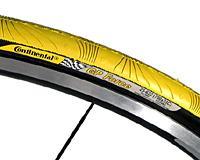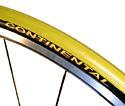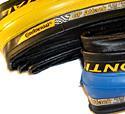
Recently on Cyclingnews.com |
On test: Continental GP Attack/GP Force, June 4, 2005
Dynamic duo
Holy tread rubber! Continental's GP Force and GP Attack combo is here to battle the evil forces of rolling resistance and punctures in one carefully-thought-out tyre pairing. Jeff Jones takes a look and refrains from further Batman & Robin references.

|
German tyre maker Continental is one of the grand-daddys of the bicycle tyre industry, established in 1892 and still going strong. Conti tyres are ridden by many of the top professional teams, and lots of races have been won on them.
The latest innovation from the German company is a front/rear tyre combination called the GP Attack and GP Force - two different designs because front and rear tyres perform slightly different tasks. According to Continental, "Steering and braking forces are transmitted on the front, whilst the rear transmits the driving forces and bears the majority of the cyclist's weight."
Most of us, including professional riders, are perfectly happy with the same type of tyre on the front and the rear. But, tyre loving guinea pig that I am, I was more than happy to test out a couple of sets of the GP Attack/Force.
Features

|
The front tyre is the GP Attack, a foldable 700x22C model with a threads-per-inch (TPI) count of 370. This is considered quite high for a clincher, and in general, an increased TPI means a suppler tyre and lower rolling resistance. The surface of the tyre is fairly smooth, but has a light tread pattern that looks like flow lines over an aeroplane wing. The GP Attack weighs 190g, which puts it on the lighter end of the racing tyre scale. That low weight is partly down to the Attack's 22mm profile. This is a shade narrower than the 23mm tyres that are almost universal, but Continental believes this is the optimum balance of rolling resistance (which increases as tyres get narrower) and aerodynamic drag (which decreases).
The GP Force is a little meatier than the Attack, and our sample weighed a still very light 210g. At 23mm, the GP Force is slightly wider than the Attack, and this is in accordance with general road racing tyre theory: it makes more sense to have a wider tyre on the rear because the forces from the rider's weight will be greater there.
The GP Force has an even higher TPI count than the GP Attack, with a five-ply design totaling 430 TPI. It's been beefed up for extra puncture resistance and high mileage. Its tread pattern is more marked and quite different from the Attack, in that the tread lines are basically perpendicular to the direction of the tyre. It certainly makes sense to add an extra layer of casing to help prevent punctures. Rear tyres get more flats because the things that cause them - shards of glass, usually - don't naturally stick up from the road presenting a sharp edge to a passing bike tyre. Rather, they lie flat. But when a front tyre hits a shard, it can flick up so that it does present a sharp edge - just in time for the rear tyre to hit it.

|
Regarding tread on racing tyres, I'm of the opinion that the smoother, the better, because you want as much rubber on the road as possible. But I have no complaints about the performance of these tyres, and I dare say that Continental probably knows a thing or two about their manufacture!
The tyres are available in black, yellow, blue, and red. Gotta love the primary colour approach.
Testing conditions
I tested two sets of tyres, one in Australia, and one in Belgium, in accordance with my usual review criteria. In Australia, I put about 1,500 km on a set before I destroyed the rear one in a crash, which I hasten to say was almost certainly not the fault of the tyre. I was cornering on a right hander at 45 km/h when a guy two wheels in front dropped himself, leaving me little time to take evasive action. I braked so hard that I took a layer of rubber off the right hand side of the tyre, before high-siding it and landing on my left side. The tyre had blown off the rim on the right side, which didn't surprise me. I did manage to stop before I came close to the guy who crashed, so at least I knew the brakes worked. That was the end of the rear tyre.
The second set enjoyed 2,500 km on the roads of Belgium in April and May, where wet roads were the norm, rather than the exception. If you want to ride a bike regularly in Northern Europe, you have to be prepared to get wet, dirty, and clean your bike lots. The good thing about Belgian roads compared to Sydney's is that there is far less broken glass, so punctures are not as common. But I do feel that the dirt and cobbles decreases component life in Belgium, tyres included.
Wear

|
Rear tyres wear faster than front ones because the rear has to transmit your pedaling force to the road, and as it does so it occasionally slips very slightly, abrading some of the tread off against the road surface. I consider 3,000 km a good amount of wear to get out of a rear racing tyre - the GP Force in this case. Although the first GP Force met with an untimely end, the second one was still going well after 2,500 km: the tread was certainly visible, there were a few small cuts in the rubber, and the tyre casing overall looked in good shape. I punctured just once in that distance, and I'm fairly sure I could get another 1,000 km out of it. So it was more than satisfactory in the wear department.
Performance
I'm of the opinion that the less you notice your equipment, the better it is. If you have to worry about the amount of overshifting required to change gear, or whether your saddle will break when you hit the next bump, this is a bad thing. The aim is to reach a state of enlightenment whereby you and your velocipede become one. This is quite possibly a bunch of crap, but it works for me. Well, it would if my bike was ever up to scratch. [Applications are open for the (unpaid!) post of personal mechanic to Dr Jones. Skills in blimp maintenance would be looked on favourably - Ed]
The Conti GP Force and Attack tyres fitted this Zen-approximation of cycling rather well. This is quite important when you are, say, cornering on wet cobbles. You don't even want to think about falling off, and I'm happy to report that these tyres stuck to the road quite nicely. They roll well and don't give a harsh ride either, and I'm guessing that this is because of the high TPI count.
Under racing conditions, the tyres also performed well. I managed to hit 61 km/h and finish top five in a bunch sprint (take my word for it, that's good for me) the first time I used them, so no complaints there.
Overall
While I am a little skeptical of the need for different tyres on the front and rear, there is no doubt in my mind that the Continental GP Attack/GP Force combination does a commendable job. At 400g a pair, they are light enough to be used for most types of road racing. I found them to be suitable for the generally ordinary Belgian weather conditions, had no problems with slippage on cobbles or in the wet, and got a decent number of kilometres out of them. Bottom line: they work.
Recommended retail price: $US49.99 ea
Measured weight: GP Attack (front): 190g; GP Force (rear): 210g
Threads-per-inch: GP Attack (370 TPI), GP Force (430 TPI)
Colour: Black, yellow, blue, red
Pro: Light, excellent wear, very good road performance
Con: None
More information: www.conti-online.com
Cyclingnews Rating: ![]()

